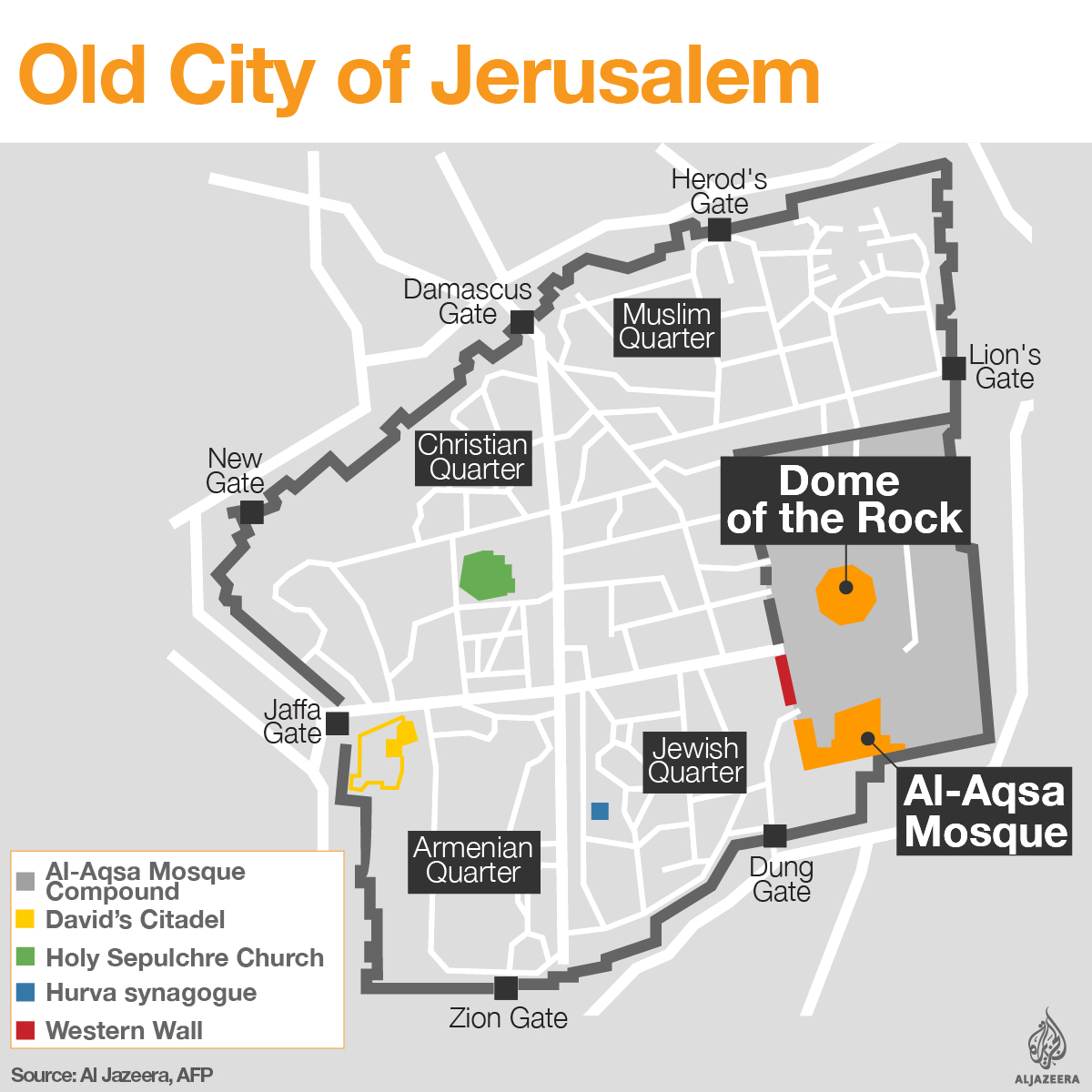Palestinians met with tear gas upon return to al-Aqsa
More than 100 injured as Israeli forces fire tear gas on worshippers re-entering holy after two weeks of protests.

More than 100 Palestinians have been injured as Israeli forces fired tear gas, stun grenades and sound bombs at worshippers who returned to Jerusalem’s al-Aqsa Mosque compound for the first time in nearly two weeks.
As the call to prayer sounded from al-Aqsa Mosque again, thousands of men, women and children made their way to the compound on Thursday, after Israel removed surveillance equipment and other obstacles from the gates leading to the holy site.
Keep reading
list of 4 itemsIsrael blocks thousands of Palestinians from visiting Al-Aqsa Mosque
Israeli forces beat worshippers outside Al-Aqsa on Ramadan eve
Photos: Aftermath of the attacks on Israel in Ashkelon
On Thursday night, dozens of Palestinians who have taken shelter inside the al-Qibli Mosque were surrounded by Israeli forces who cut off electricity in an attempt to force them outside of the compound.
Earlier in the day, the scenes of eupohria and celebrations inside the compound were cut short by Israeli forces who stormed in at the heels of the crowds that had entered the al-Aqsa Mosque complex.
Raed Saleh, a resident of occupied East Jerusalem, said that re-entering the compound on their own conditions was a victory for Palestinians.
“We never saw this kind of win for our people,” he told Al Jazeera. “People are coming from everywhere just to support us in this occasion.
“The Israeli government will now understand that Palestinians from Jerusalem will not accept everything they [Israelis] will tell them. We control ourselves. No one is controlling us.”
READ MORE: Five things you need to know about al-Aqsa
The metal detectors were removed overnight Wednesday by Israeli authorities.
Newly installed railings and scaffolding where cameras were previously mounted were also cleared early on Thursday, after which Israeli police declared that all new security measures had been removed.
|
|
Palestinians had gathered at al-Aqsa on Thursday after officials from the Islamic Waqf authority, which administers al-Aqsa Mosque compound, gave the go-ahead to return to performing prayers there.
However, one of the gates, Bab Hutta, remained closed by Israeli forces and Palestinians refused to enter until all Israeli-imposed measures were removed from the gates.
Israeli security forces followed the worshippers in from the Bab Hutta gate and fired stun grenades, sound bombs and tear gas. According to the Palestinian Red Crescent, 113 people have been injured as a result.
Speaking from occupied East Jerusalem, Al Jazeera’s correspondent Imran Khan said that he saw Palestinians being brought out of the compound’s gates injured.
“Sporadically you hear stun grenades go off, you hear tear gas being used inside the al-Aqsa Mosque compound by Israeli security forces and the use of rubber-coated steel bullets,” he said.
“Right now inside the compound there’s a hell of a lot of tear gas being used and people coming out with their eyes streaming. Every so often we see Palestinians running, trying to avoid the heavy-handed dispersal tactics that the Israelis [are using].”
![Palestinian paramedics carry an injured woman on a stretcher after clashes [Ahamd Gharabli/AFP]](/wp-content/uploads/2017/07/2d9f214554d2482dbc7b75bcd12de55d_18.jpeg)
Palestinians were later pushed back by Israeli police from Lions’ Gate, one of the main protest points, and not allowed to enter the compound.
A live video posted on Facebook showed hundreds of Palestinian worshippers performing the sunset prayer inside the compound.
Meanwhile, the Arab League said that Israel’s removal of new security measures had solved the immediate crisis but urged it to learn lessons by desisting from any such steps in future.
“Israel’s withdrawal from its provocative and illegal actions solves the crisis they themselves created,” Ahmed Aboul Gheit, Arab League secretary-general, said at an emergency meeting of Arab foreign ministers on Thursday.
“Dealing with Islamic sanctities with such imprudence poses a real threat of igniting a religious war, because no Muslim in the world accepts tarnishing al-Aqsa or its closure in the face of the worshippers or placing it under Israeli control.”
READ MORE: Palestine envoy to UN: Al-Aqsa crisis at tipping point
For 13 days, Palestinians had protested night and day, refusing to pray inside the compound after Israel installed metal detectors at its entrances.
They held prayers in the streets and just outside the gates to the Old City.
Palestinians viewed the installation of the surveillance equipment as Israel asserting further control.
The new regulations came after an attack on July 14 by three Palestinian citizens of Israel, who killed two Israeli policemen in the Old City of Jerusalem.
The three men were then chased inside the compound before they were shot and killed.
![Palestinians and Israeli border police officers clash inside the compound [Mahmoud Illean/AP Photo]](/wp-content/uploads/2017/07/fa9e4cf6e85d4d9d9b71a28a60cc524c_18.jpeg)
The following week, three Palestinians were killed in Friday protests by Israeli forces in what was dubbed a “day of rage”.
Later that night, three Israelis were stabbed to death by a Palestinian who entered their house in a West Bank settlement.
The compound, known to Muslims as the Noble Sanctuary and to Jews as the Temple Mount, is in occupied East Jerusalem.
It was seized by Israel in the 1967 Six-Day War and later annexed in a move never recognised by the international community.
